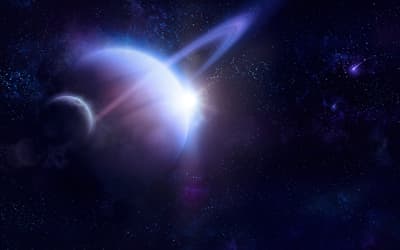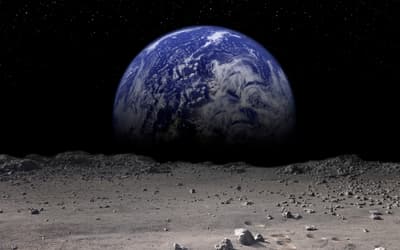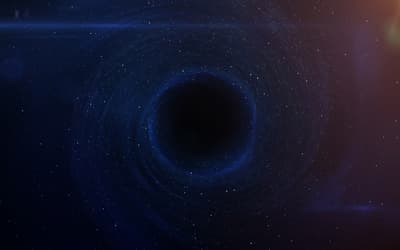Research conducted by Answers in Genesis staff scientists or sponsored by Answers in Genesis is funded solely by supporters’ donations.
Abstract
Asteroids and comets long had been viewed as distinct objects with regards to orbits and composition. However, discoveries made in recent years have blurred those distinctions. Whether there is a continuum on which our older conception of asteroids and comets are extremes or if there still is a gap between them is not entirely clear yet. Some of the newer views of comets and asteroids may challenge the evolutionary theory of the solar system. Additionally, the new information may challenge the idea that the solar system is billions of years old. For readers not versed in nomenclature of small solar system bodies, I discuss that in the appendix.
Keywords: small solar system objects, comets, asteroids (minor planets)
Introduction
The differences between asteroids and comets
At one time, we thought of asteroids and comets as being two very different groups of objects. Comets and asteroids certainly looked different. Comets can be visible to the naked eye, and have been known since ancient times. They have a hazy, fuzzy appearance. In fact, the word “comet” reflects what they look like, for it comes from the Latin word for hair, chosen because comets resemble hairy stars. Comets were an enigma to the ancients, because they defied the constancy and regularity that astronomical bodies normally followed. Comets would appear abruptly in the sky, move in an erratic fashion, and then fade from visibility. On the other hand, asteroids generally are too faint to be visible to the naked eye (one asteroid, 4 Vesta, occasionally is barely visible to the naked eye). Being so faint, the first asteroid was not discovered until 1801, long after the invention of the telescope. Even through a telescope, an asteroid appears but as a faint star, hence the term asteroid, meaning “star like.”
The observed differences between asteroids and comets are attributed to differences in composition. Astronomers thought that asteroids primarily were rocky, while comets mostly consist of various ices with an admixture of fine dust particles. The orbits of comets and asteroids are very different too. Asteroids have nearly circular orbits around the sun that are inclined very little to the earth’s orbital plane.1,2 These orbits are similar to the orbits of the planets. To drive home this similarity, the preferred scientific term for asteroids is minor planets. On the other hand, comets have highly elliptical orbits around the sun, and their orbits frequently are inclined considerably to the orbits of the planets. Because of their highly elliptical orbits, most comets alternately are very close to the sun when near perihelion and very far from the sun when near aphelion. Comets spend most of the time near aphelion far from the sun, so that their ices remain frozen. However, when a comet nears perihelion, the heat of the sun sublimes many of the ices to form a large cloud of gas called the coma. Solar radiation excites the gas in the coma, and the gas fluoresces, causing the coma to brighten considerably. This is why comets near perihelion can become very bright. The solar wind and solar radiation push the gases in the coma and dust particles dislodged from the comet away from the sun to form a comet’s tail. When far from the sun, a comet is very faint, because there is little sublimation of gases. On the other hand, minor planets shine solely by reflected sunlight. Because of their low eccentricity orbits, minor planets maintain a nearly constant distance from the sun, and so the amount of solar radiation reaching them does not change much. The primary factor that affects how bright a minor planet appears is its distance from the earth. Hence, minor planets do not vary in apparent brightness nearly as much as comets do.
The orbits of most minor planets are in the asteroid belt, a broad region between the orbits of Mars and Jupiter.3The asteroid belt appears to be the transition between the inner and outer solar system: the four planets closer to the sun than the asteroid belt (the terrestrial planets) are rocky, while the four planets beyond (the Jovian planets) are gaseous. We know that the terrestrial planets are rocky, because of their high density. On the other hand, the Jovian planets have low density, from which we conclude that they consist mostly of hydrogen and helium, with a small admixture of other elements. The satellites of the Jovian planets generally have low density as well, consistent with high ice content with some rock. When one factors in the large gravity of the Jovian planets, and hence their ability to retain hydrogen and helium as compared to much smaller objects, it is reasonable that the outer planets have composition similar to their satellites. Smaller bodies, such as Jovian planet satellites, lack sufficient gravity to hold onto helium or elemental hydrogen that they may have once contained. That is, objects in the outer solar system have similar composition—an admixture of some rocky material with a much greater amount of the lighter volatile elements that form ices at low temperatures. Given their high orbital eccentricities, comets spend most of the time far from the sun and thus are members of the outer solar system, so we ought not to be surprised that comets share similarity in composition with objects so far from the sun. However, due to their eccentric orbits, comets are the only denizens of the outer solar system that venture closely to the sun. When comets approach close to the sun, the development of their comae reveals their out of place composition. For a long time, astronomers thought that minor planets within the main belt were well within the region dominated by rocky rather than by icy composition. In retrospect, that belief probably was a bit naïve, and one ought to have been able to anticipate the blurring that has occurred in recent years. Astronomers now think that there may be a continuum of properties of the smaller bodies in the solar system. The classical view of comets and minor planets may represent the extreme ends of that continuum. Astronomers now group all comets and the vast majority of minor planets into small solar system bodies.
The Situation Gets Murky
Probably the first challenge to the tidy dichotomy between minor planets and comets was the discovery of the minor planet 2060 Chiron4 in 1977 (Kowal 1977). At the time of its discovery, Chiron was more distant from the sun than any known minor planet. Some press accounts at the time even hailed it as the tenth planet, though it obviously is far too small for anyone seriously to suggest that Chiron indeed ought to be a planet. The semi-major axis (the average distance from the sun) of Chiron’s orbit is at 13.7 AU, placing it well beyond the orbit of Saturn. However, due to its moderate orbital eccentricity (0.38), Chiron’s perihelion is slightly within Jupiter’s orbit, and its aphelion is nearly as distant as Uranus’ orbit. Given that Chiron orbits well within the domain of the outer solar system, astronomers at the time assumed that Chiron probably consisted of a mix of ice and rock similar to most outer solar system objects. However, its orbital inclination was low, about 7°. The orbit suggested the Chiron was a minor planet, albeit near the upper limit of asteroid orbital eccentricity. That is, while the inferred composition of Chiron more closely resembled that of comets, its orbit was viewed as more similar to minor planets. As long as Chiron did not exhibit any cometary behavior, it was safely classified as a minor planet. However, in 1988 Chiron was closer to perihelion than it was at its discovery a decade earlier, and it brightened. By the next year it had developed a coma (Meech and Belton 1989). Now astronomers classify Chiron as both a minor planet and a comet (its comet designation is 95P/ Chiron). Because of its dual nature, Chiron’s name was aptly chosen, for in Greek mythology, Chiron was a centaur, half horse and half man. Since the discovery of Chiron, about 150 other minor planets are known with semi-major axes among the Jovian planets, though there are probably tens of thousands of them yet to be discovered. Because Chiron was the first discovered of this group, astronomers use it to define the centaurs, a class of small solar system bodies that orbit the sun between the orbits of the outer planets. In addition to Chiron, a few other centaurs exhibit some coma activity. One example is 174P/Echeclus (60558) (Choi and Weissman 2006), which was classified as a minor planet originally and later received a cometary designation. Three other examples, 165P/LINEAR, 166P/NEAT, and 167P/CINEOS, never were classed as minor planets, because they were recognized as comets at the time of their discovery. It is likely that most centaurs develop comae, though the comae of many of them may be too faint for us to detect them.
Interestingly, the first centaur discovered was 944 Hidalgo, back in 1920. However, the true nature of Hidalgo was not appreciated until after the discovery of Chiron. While the semi-major axis of Hidalgo’s orbit is just beyond the orbit of Jupiter, its aphelion is nearly to Saturn’s orbit and its perihelion is 1.95 AU from the sun, in the inner edge of the asteroid belt. Both Hidalgo’s orbital eccentricity (0.66) and orbital inclination (42°) are moderately large, and hence more similar to comets than to minor planets. However, since Hidalgo has not produced a coma, for many years after its discovery astronomers assumed that Hidalgo was a minor planet (presumed to be rocky) that had been gravitationally perturbed into its peculiar orbit. It was not until much later that astronomers began to question the assumption that Hidalgo was rocky.
Another line of evidence that has blurred the distinction between comets and minor planets came with the search for the Kuiper belt, the supposed source of short-period comets. For a discussion of the Kuiper belt in the creation literature, see Faulkner (1997). The first fruit of this search was the as yet unnamed minor planet, (15760) 1992 QB1. While there are nearly 700,000 known minor planets at this time (early 2015), only about 1500 have been found beyond the orbit of Neptune, where most astronomers expect the Kuiper belt to be. There are two alternate names for small objects beyond the orbit of Neptune–Trans Neptunian Objects (TNOs) or Kuiper Belt Objects (KBOs). Which term one uses often is determined by whether one believes that we actually have found the Kuiper belt. I shall use TNOs here. In retrospect, most astronomers now think that Pluto (discovered in 1930) and its satellite Charon (discovered in 1978 [Smith and Christy 1978]) were the first discovered TNOs. To reflect this reality, Pluto and Charon have received minor planet designations—Pluto is officially known as 134140 Pluto and Charon is officially designated as 134340 Pluto I. Charon’s designation follows the convention of naming satellites of planets (the Roman numeral I indicates that it was the first discovered satellite of Pluto), nor is it likely, for historical reasons, that they ever will. It is unlikely that they will ever be given cometary designations, even if astronomers were to decide definitively that they are comets. The densities of Pluto, Charon, and a few other TNOs that have been measured are consistent with the high ice composition so common with other outer solar system objects, but this is not surprising.
Astronomers had long assumed that asteroid belt objects were dry and rocky. This began to change in 1996 with the discovery that the main belt asteroid 7968 Elst-Pizzaro, previously discovered in 1979, developed a tail (Elst et al. 1996). This led to its classification as a comet, 133P/Elst-Pizarro. Soon a few objects within the asteroid belt displayed similar activity. Now astronomers refer to these objects as main belt comets, though some astronomers now prefer to call them active asteroids. Some of these objects originally were thought to be minor planets and hence had received designations as minor planets. As with 7968 Elst-Pizzaro, some receive designations as comets as well. Hence, a few objects have rare dual classifications as both minor planets and comets. However, in some cases, such as 596 Scheila, they are not given a comet designation. Other objects within the asteroid belt, such as 311P/PANSTARRS, are recognized as comets at discovery. These objects do not receive a dual designation as minor planets. The reason is that the sequential numbers that asteroids receive are in order of discovery. With the length of time often required for reclassification and the rapid pace at which asteroids are discovered, it is not possible to retroactively assign a sequential number to objects later determined to be asteroids.
This situation with Pluto illustrates this problem. In 2006, the International Astronomical Union (IAU) for the first time defined what a planet is in a manner that disqualified Pluto as being a planet (Faulkner 2009). At this time, Pluto was officially given a minor planet designation, using the first available number, even though that number was out of sequence of discovery. Pluto is a unique case, and the IAU is unlikely to grant other exceptions. Pluto’s unique status may be why the IAU created the class of dwarf planets at the same time that it changed Pluto’s status—the IAU knew that it could not give Pluto a minor planet designation, but the IAU felt that there needed to be some category for Pluto. A major reason why the IAU removed Pluto from the list of classical planets was that its mass and size was similar to a dozen or so newly discovered TNOs. One (136199 Eris) was perhaps even larger than Pluto. However, no astronomer would seriously consider Pluto to be a comet. The best definition of a comet is a spectral definition—it is a diminutive asteroid-like body that emits an emission spectrum from sun heated gasses. Once an asteroid shows an emission spectrum, it becomes a comet.
Recently, the main belt comet P/2013 R3 was observed to split into several pieces (Jewitt et al. 2014). Comets frequently have been observed fragmenting into several pieces, but this is a first for a main belt comet. Comet disruption can have several causes. The two most obvious causes of comet break up are tidal disruption and the buildup of pressure due to subliming gases. Another possibility is passage through the sun’s magnetic field reversal— going through magnetic north to south or south to north along the equator of the sun can break pieces of the comet apart. However, P/2012 R3 was far from any other body capable of producing sufficient tidal stress, and there was no evidence of gaseous emission, which severely limited the amount of volatiles released in this event. It is possible that an impact could have disrupted this object, but another possibility is the YORP torque. YORP, from the Yarkovsky-O’keefe-Radzievskii-Paddack effect, is a speeding up of the rotation of an irregularly shaped body exposed to sunlight (Rubincam 2000). The absorption and remission of sunlight can carry off momentum. If a body is irregularly shaped (as most minor planets and comets are), then the preferential angular momentum loss actually can speed the rotation rate. A more rapidly spinning object can lead to induced structural failure.
The lack of gas emission is common in main belt comets. This is a significant difference from classical comets in that classical comets always have bright emission in their coma, which is evidence of abundant gas in their comae. The comae of the main belt comets are dominated by dust, not gas. Therefore, while main belt comets have a superficial resemblance to classical comets, there is still a gulf between their behaviors. If there is a continuum it is not known yet. Exactly what is going on with main belt comets is debated among astronomers. Much of the coma activity occurs near perihelion, suggesting that the dust is ejected at least by subliming volatiles near the surface of the body. However, most astronomers think that the bodies involved are billions of years old, so any volatiles near the surfaces of the bodies would have sublimed long ago. To explain this, many astronomers suggest that collisions with smaller bodies excavate material from the surface to expose still frozen volatiles deeper inside that had been insulated from heat due to surface absorption of solar radiation. The study of main belt comets is in its infancy, but this may be evidence that main belt comets are far younger than the billions of years normally thought. This deserves further research on the part of creation scientists.
Our changing understanding of comets and asteroids owes much to the availability of much larger telescopes and more sensitive detectors than existed just a few years ago. Astronomers now can observe outbursts on faint minor planets that would not have been possible until recent years. Presumably, outbursts and plumes coming from some minor planets have always happened, but we did not know about them until recently. Since these behaviors superficially resemble cometary behavior, astronomers had little choice but to classify these objects as comets, though the underlying mechanisms may be markedly different. Perhaps terminology and classification will continue to change, and eventually they will catch up with the observations. For now, we can list a few general characteristics of comets that differentiate them from asteroids. The measured density of a comet is usually very small, something like 0.1–1.2 g/cm3. They are better described as small ice-rocky amalgams that have very elliptical, highly inclined, and sometimes retrograde orbits around the sun. A key characteristic is their emission spectra.
Conclusion
At the very least, it appears that the solar system has a second asteroid belt beyond the orbit of Neptune. This ought not to be any more surprising than that there is an asteroid belt between the orbits of Mars and Jupiter. While we probably would expect the objects in the second asteroid belt to be icy, why would we expect all members of the classical asteroid belt to be rocky? Being much closer to the sun, objects in the inner solar system are low in ice content, but why would the transition point be beyond the outer edge of the classical asteroid belt? That is, the inner portion of the belt likely is rocky, but the outer portion could be icier. Why would the transition from rock to ice be stark? Why could not the transition be gradual, with an increasing trend in ice percentage with increasing distance from the sun in the asteroid belt? Furthermore, objects in the asteroid belt are not static—objects in the main belt probably are jostled and moved to higher and lower orbits. Hence, an icier body from the outer edge could migrate into the inner portion of the belt.
For a long time, astronomers have assumed a 4.6 billion year evolutionary history of the solar system. Through a process not really understood, a cloud of gas with a small component of dust supposedly began to collapse under its own gravity. Most of the material fell to the center to produce the sun. The remaining material collapsed into a disk outside the forming sun. Through another process not really understood either, the disk material supposedly began to accumulate into larger particles. Astronomers call the hypothetical growing particle planetesimals. The largest planetesimals accumulated enough mass so that their gravity dominated their respective regions. These growing objects became the planets. The remaining material formed the planetary satellites, minor planets, and comets. No object became dominant in either of the two asteroid belts. The gravity of the outer planets stirred up the outer asteroid belt to populate the Oort cloud, from which long-period comets supposedly come. Because of their close proximity to the forming sun, planetesimals in the inner solar system were sufficiently heated to remove the lighter, volatile elements, leaving only higher melting and evaporation point materials in those planetesimals. According to the evolutionary theory, this explains why the inner, terrestrial planets are rocky. Being much farther from the sun, the planetesimals that formed the Jovian planets and other objects of the outer solar system remained cold and hence retained their lighter materials. This supposedly explains the composition of outer solar system objects being rich in volatiles.
Our understanding of the composition of minor planets and comets is rapidly changing. Minor planets and comets no longer represent extremes, but rather our classical understanding of them may represent extremes of a continuum of some sort. This progress is worthy of further monitoring by creationists, and a more detailed study of the composition of small solar system bodies is most wanted. A significant number of bodies in the asteroid belt may have modest levels of volatiles near their surfaces. If so, that may be difficult to explain in terms of a solar system that is billions of years and developed as outlines above.
References
Choi, Y.-J., and P. Weissman. 2006. Discovery of cometary activity for Centaur 174P/Echeclus (60558). Bulletin of the American Astronomical Society 38:551.
Elst, E. W., G. Pizarro, O. Pizarro, C. Pollas, J. Ticha, M. Tichy, Z. Moravec, and W. Offutt. 1996. Comet P/1996 N2 (Elst-Pizarro). International Astronomical Union Circular no. 6456.
Faulkner, D. R. 1997.Comets and the age of the solar system. Creation Ex Nihilo Technical Journal 11, no. 3:264–273.
Faulkner, D. 2009. Planet Pluto 1930–2006. Creation Matters 14, no. 1:1–3.
Jewitt, D., J. Agarwal, J. Li, H. Weaver, M. Mutchler, and S. Larson. 2014. Disintegrating asteroid P/2013 R3. The Astrophysical Journal Letters 784, no. 1:L8.
Kowal, C. T. 1977. Slow moving object Kowal. International Astronomical Union Circular no. 3129.
Meech, K. J., and M. J. S. Belton. 1989. Chiron. International Astronomical Union Circular no. 4770.
Rubincam, D. P. 2000. Radiative spin-up and spin-down of small asteroids. Icarus 148, no. 1:2–11.
Smith, J. C., and J. W. Christy. 1978. P1. International Astronomical Union Circular no. 3241.
Appendix
Nomenclature of small solar system bodies and other technical terms
Readers not deeply familiar with astronomy may be curious about the nomenclature concerning small solar system objects in this paper, as well as some other technical terms related to orbits. In this appendix I explain some of the terms and the nomenclature of small solar system objects.
Astronomers normally express distances within the solar system in terms of the astronomical unit (AU). The AU is the average distance between the earth and the sun. In discussing orbits, there are several important terms. Four centuries ago, Johannes Kepler demonstrated that the orbits of the planets are in the shape of ellipses with the sun at one focus. We call this fact Kepler’s first law of planetary motion. All closed orbits, the sort of orbits that minor planets and comets have, follow this rule. The point on an orbit closest to the sun is called perihelion, while the point on the orbit most distant from the sun is the aphelion. The line connecting perihelion and aphelion, the longest diameter of the orbit, is the major axis. Half the major axis (the semi-major axis) is the average distance of the orbiting body from the sun. Ellipses can have different shapes, from a perfectly round circle to a much flattened ellipse. We express how flat an ellipse is by its eccentricity. A circle has zero eccentricity, while the most flat ellipses have eccentricity of nearly one. Planets have orbits that are close to being circles, so their orbital eccentricities are only slightly larger than zero. An orbit’s elliptical shape defines a plane. The amount of tilt between an orbit’s plane and the earth’s orbital plane is the inclination. Planet orbits have very low inclination.
The International Astronomical Union (IAU) is the officially recognized body that defines astronomical terms. In recognition of the blurring distinction between comets and asteroids, in 2006 the IAU created the category of small solar system bodies. A small solar system body (SSSB) is any object in the solar system that is not a planet, a satellite of a planet, or a dwarf planet. A dwarf planet is a category also created by the IAU in 2006 that includes any object that orbits the sun, but is too small to be a planet yet has enough mass for its gravity to have formed itself into a spherical shape. At this time, there are five recognized dwarf planets: Pluto, Ceres, Haumea, Makemake, and Eris, though the list is almost certainly going to increase. Of course, from its discovery in 1930 to its change in status in 2006, Pluto was considered a planet; the other four objects had been, and in a sense continue to be, asteroids, or minor planets. With the exception of the few dwarf planets, SSSBs include all objects usually known as comets or asteroids.
The IAU also maintains procedures for naming comets and asteroids. Some notable comets of the past frequently are referred to by historical names, such as Halley’s Comet or the Great Comet of 1680. However, for most comets the current system of naming comets adopted in 1994 is the preferred standard. The first part of the name is one of five possible capital letters. The two most commonly used letters are P and C, and they are the ones of interest to us here. Respectively, they refer to periodic comets and non-periodic comets. While all comets approaching the sun are periodic in the sense that if they remain on their current orbits they eventually will return to the sun, the periods often are so long that it would take many thousands or even millions of years to return to the sun. If a comet’s orbit is less than about 200 years, it is likely that we have records of observations from previous trips close to the sun, so we can confirm its orbit. We give such comets the designation P, standing for periodic. Otherwise, the comet receives the designation C, simply for comet. If a comet is periodic, it is assigned a sequential number in order of its recognition as a periodic comet. Since Edmund Halley was the first to do this for his famous comet, Halley’s Comet is given the number 1. The official designation of a comet begins with this capital letter (usually C or P), followed by a slash, the year of discovery, another capital letter, and then an Arabic numeral. The second letter indicates which half-month of the year that a comet was discovered. The first half of January is A, followed by B for the second half of January, and so forth. However, because it could be confused for the numeral 1, the letter I is not used. Hence, the letter Y refers to the second half of December. Since it is not needed, the letter Z is not used either. The numeral indicates the order of discovery during the half-month. Often, the name of the discoverer or discoverers is appended in parenthesis. For instance, C/1996 B2 (Hyakutake) was a non-periodic comet discovered by someone named Hyakutake in 1996. This particular comet was the second one discovered during the second half of January that year. Halley’s Comet is officially known as 1P/1682 Q1.
The IAU has adopted a similar convention for identifying asteroids. When an asteroid is discovered, it is given a provisional designation of the year of discovery followed by a code indicating the order of discovery. As with comets, the first part of the code consists of a capital letter indicating the half-month of discovery, again omitting the letter I and not using Z. However, unlike comets where the order of discovery within the half-month is indicated by a numeral, the order of discovery is indicated by a sequential capital letter, again omitting the letter I. Because the letter Z is used here, this can accommodate up to 25 asteroid discoveries per half-month. As is often the case now, if more than 25 asteroids are discovered in a half-month, the letters are recycled but a subscripted numeral 1 is appended to indicate that the letters have been cycled once. Each recycling of letters in a half-month requires incrementing the numeral. Sometimes, because of formatting problems, the subscripted numeral ends up not being subscripted. Once an asteroid’s existence is confirmed and there is a reliable orbit computed for it, a sequential number in order of confirmation is appended to the front of the asteroid’s designation, usually in parenthesis. For instance, consider the asteroid (15760) 1992 QB1. The designation reveals that this minor planet was the 27th one discovered in the second half of August 1992, and the 15,760th confirmed minor planet discovery overall. Finally, an asteroid may be given a formal name. When the first asteroids were discovered two centuries ago, astronomers thought that they were planets, so they followed the ancient custom of naming planets after gods in the Roman pantheon. Soon most of those deities were exhausted, so astronomers moved on to other mythologies and then on to famous scientists, philosophers, authors, composers, and other prominent individuals. The IAU has established formal rules for proper names. At one time, it was standard practice eventually to name all confirmed asteroids, but with the tremendous increase in the pace of discoveries, few asteroids now receive proper names. In referring to an asteroid with a proper name, it is common to omit the year and order of discovery designation and simply give the sequential number of confirmation, without parenthesis, followed by the proper name. An example of this is 2060 Chiron.
The pace of asteroid discovery has increased tremendously in recent years. It took 170 years to reach 2000 known asteroids. That was in the year 1973. It took less than a decade to reach 3000, and then only about seven years to reach 4000, and only four more years to reach 5000. The pace of discovery hugely accelerated about the year 2000. Today, there are more than 600,000 known asteroids, with many thousands discovered every year. There are several reasons for this. Much of this has been fueled by increased detector efficiency. Modern CCD cameras can capture the same light level in 1–2% of the time required just a few decades ago. At the same time, there has been a large increase in the number of larger telescopes. With the unprecedented computer capabilities today, many telescopes are automated to look for SSSBs. This makes the search very efficient in terms of cost. Three of these are worthy of note. The Pan-STAARS (Panoramic Survey Telescope and Rapid Response System) consists of two 1.8 m telescopes that rapidly survey the entire sky visible from their location in Hawaii. A smaller telescope does follow-up work. LINEAR (Lincoln Near-Earth Asteroid Research) has two 1.0 m telescopes in New Mexico, which, as the name suggests, were designed to search for asteroids that pass close to earth and hence could collide with earth. The Catalina Sky Survey (CSS) employs a 1.5 m telescope and a 0.068 m telescope in Arizona, as well as a 0.5 m telescope in Australia to search for near-earth asteroids as well.
In addition to finding asteroids, these telescopes also discover comets, so comets found in recent years frequently carry the name PanSTARRS or LINEAR. These instruments have greatly increased the number of comets found each year. Just 40 years ago, not much more than a dozen comets were found each year, now several score comets are found each year. As with asteroids discovered now, most of these are extremely faint and would have evaded detection just a few years ago. Thus, while it may look like there are more comets today than in the past, it is just that in the past we would not have seem most of them.










